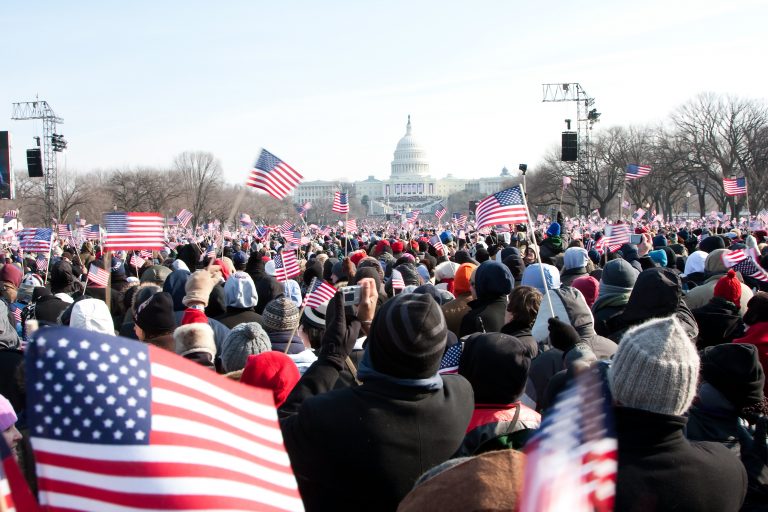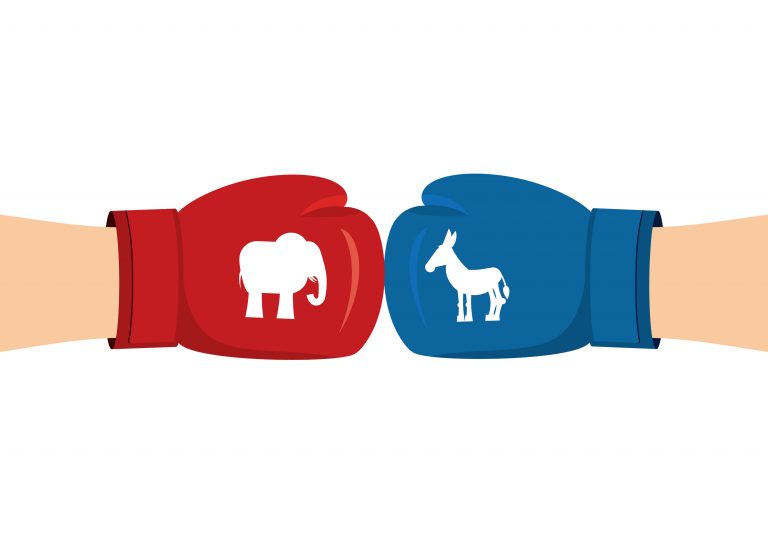Why begin conversations to articulate a current American spirit at a time when we are so divided and angry? The accurate but perhaps facile answer is that our nation most needs to embrace what we share and treasure at times of greatest division. The accurate and more in-depth answer is offered here is one that acknowledges that our bitter divides will make the conversation challenging and, with that in mind, suggests a path for conversations that might lead to identification of national aspiration with support across our major divisions.
Anger represents formidable headwinds for such a conversation project, and if you do not already appreciate that fact, read this paragraph and the next. American’s political identities seem increasingly to be turning into personal identities, according to polling. For example, Pew Research reveals that most Democrats and Republicans now view members of the other party negatively for the first time in the survey’s 25-year old history. Polls also say that Republicans increasingly view Democrats as extremists and vice versa. Americans have reached a 25-year high in not wanting an immediate family member to marry someone from the opposing political party. In addition to polls, each day provides an abundance of examples of the deep divisions in this country on policies that range in focus from economic mobility/profitability, to environmental impact/industrial regulation.
Technology and its accompanying reward structures seem almost to “weaponize” our divisions, given the increases in speed and the polarizing incentives. Especially in an era of social media, advocates of any position are rewarded for higher outrage levels in terms of hits, coverage, and financial compensation. Politicians experience high online campaign giving in response to their hard-hitting social media posts. Social media platforms offer posting priorities to facilitate users who want what they read to echo their own views. The constant deluge of news increases the impact of traditional rewards for covering conflict, but much less so for constructive cooperation. Note how little coverage was given to the fifty freshman Congressional members who committed to civility in the 115th Congress.
What are the tailwinds for a conversations project? Research indicates that we yearn to move beyond current polarization. A number of commentators such as David Brooks, Yuval Levin, William Choslovsky, Nancy Gibbs, Dan Alexander, and David McCullough (this year alone) reflected this yearning when they challenged Americans to articulate their common aspirations – what we call here an American spirit. Gibbs sounded the alarm many feel as she observed, “Unifying values, around speech and civility, freedom and fairness are shredded by rising tribal furies and passions.” Historian David McCullough suggested action when he recalled how throughout history, Americans have found an “inexhaustible source of strength” in their common aspirations. Some of the commentators have observed that an American spirit would help focus Americans on the problems that currently seem intractable.
In this blogpost, we use our conflict resolution experience to take on the challenge of starting a conversation on American spirit, because we, like these commentators, see the need for more constructive conversations and real problem solving in this country that can only come about with a touchstone of shared values. That’s what a national spirit can provide.
History does not provide a perfect guide on what process to use. Pronouncing an American spirit in times of bitter divides has been the stuff of giants. We think of President Abraham Lincoln, who enjoyed wide and near-reverent admiration, universal attention, story-telling acumen, and uncommon insight into his fellow Americans. Nonetheless, there is a grassroots alternative to the identifying a current American spirit, one that is thoughtfully and systematically approached, in order for it to be widely and deeply embraced.
We offer thoughts, based on our conflict resolution experience, on:
- How a national spirit helps polarized people solve their problems.
- Potential ways to screen ideas for the American spirit for those with the power to ameliorate the current polarization.
- How one convenes and holds the conversations necessary.
How a national spirit helps
Picture the two horned goats in Aesop’s fable who face off on a narrow branch spanning a cavernous gorge. That is close to how angry and spiteful people feel across political divides. It’s too late to save the goats, who did not bring their common peril to mind quickly enough, but an American spirit might yet put in the forefront of our minds the bigger picture for Americans – what we share and will work hard to avoid endangering. Mediators of both large- and small-scale conflict understand this about people who have in mind what they share and value: they will more often pursue collaborative approaches, consider other viewpoints, prioritize in how and what they advocate, and resist divisive rhetoric. Applying that to our nation, a powerful American spirit would provide safe space to tamp down polarization and explore disagreements; forge common ground; and inspire us to work together for the long term. That would help right now.
Unfortunately, we seem collectively unaware of a current American spirit that might play that role. 71% of us think that we are losing an American spirit, according to a 2017 poll by the Associated Press-NORC Center for Public Affairs Research.
Ways to screen various ideas for a current American spirit
We have one tool that President Lincoln lacked – the ability to poll our fellow Americans and determine whether a potential strain of an American spirit will resonate deeply and broadly among various ideological groups, recognizing that no single idea will be universally supported. But we need to narrow the candidates for a current American spirit before polling can play that role. Fortunately, an interdisciplinary group of scholars examined national identities for decades and their work suggests some questions to ask that will bring the most powerful proposed American spirits to the fore:
First, does the potential American spirit point toward bridging differences? Love of family, though a widespread value, does not focus specifically on overcoming ideological differences, for example. An example of a potential American spirit more closely directed toward dislodging current bitterness comes from David McCullough, William Choslovsky, and David Brooks. Their proposals lean toward forgiveness, redemption and openness to change. When combined, their proposed American spirit is something like this: Americans are explorers and experimenters who seek new frontiers. This constant yearning is reflected everywhere from our music to our innovative industries. We Americans innovate as well in assuring the freedom and equality that are at the heart of this ever changing democracy.
Second, do Americans feel that this American spirit is especially – better yet uniquely – ours? If so, it has more strength because we feel it more deeply: “Is this spirit something previous generations felt? Is this spirit something today’s generation feels? Why would we be the first generation to destroy something that special?” For example, as Americans we might identify courage as part of an American spirit. It might not be perceived at first as unique and therefore might not be felt as deeply. However, America pioneered freedom based on democratic rule and defended it bravely through the Revolutionary War, Civil War, World Wars, among others, exercises in courage that are proud aspects of our history, ones that Americans might be inspired to preserve.
Third, can we embrace the American spirit without changing our habits and beliefs in some fundamental way? We are not likely to be willing to do so just because someone articulates a potential American spirit. That spirit should call on our best impulses but it must seem authentic, natural. It should be a touchstone already of the American psyche at a basic level. An American spirit that highlights justice for all might not be a surprise to Americans, given that these are the last words of the American Pledge of Allegiance and the story of America from the earliest days onward recounts struggles for justice by individuals and groups who experienced wrongs from incarceration to denial of suffrage to labor exploitation.
Fourth, does the proposed American spirit formulation incorporate the interests underlying the policy positions taken by the primary ideological groups, so that it will resonate broadly? For example, some Americans are tired of change and place a high value on traditional ways. Does the spirit tie into both of those traditions? Social psychologist Jonathan Haidt has reflected on questions three and four, in his recent book Can’t We All Disagree More Constructively.
Fifth, does the potential American spirit formulation provide a reason for optimism and a sense of belonging as an American? Fear, pessimism, and isolation underlie much of today’s bitterness. Just last month, a Gallup poll revealed 70 percent were dissatisfied with “the way things are going in the U.S.” Fear is a near cousin is alienation and discouragement. Remember how we nodded when we heard wise Yoda in the Star Wars movie explain, “Fear is the path to the dark side. Fear leads to anger. Anger leads to hate. Hate leads to suffering.”?
Holding the conversations to identify potential strains of a current American spirit that will be widely and deeply embraced
Given the personal nature of our political differences and the challenges of discussing issues such as racial and ethnic equity in constructive ways, we should use facilitators gifted in helping us to be uncharacteristically thoughtful and open as we listen for those interests and aspirations that we share. Facilitators through their presence and skill can prevent conversations from becoming “us versus them” and help hold a value like an American spirit as a solid presence within a potentially adversarial conversation. They personify that a dialogue should not just be two opposing and uncompromising perspectives by helping the individuals listen to each other, ask clarifying questions, and highlight agreements, and ultimately by helping the individuals improve their relationships and the outcomes.
We are not media experts, so we will leave it those who are to work on the communication aspect of an American spirit for the technological times we now live in. Is technology an answer to how someone other than Abraham Lincoln effectively communicates a current American spirit, once identified? Those of you with media expertise are key to the success of any grass-roots American spirit project.
A few more thoughts
Are you still thinking, “It is more important to…..,” adding in what laws you want changed, what candidates you want elected? If so, please consider this: our greatness as a country has been based on people fighting for what’s right through elections, litigation, and legislation, while simultaneously working together as Americans, whether in wartime or peace. We can do that advocacy and simultaneously collaborate in articulating a new American spirit.
Nancy H. Rogers is a member of the executive committee for the Divided Community Project, former Dean of the Ohio State University Moritz College of Law and now Director of its Program on Law and Leadership, and former Ohio Attorney General. Grande Lum is the director of the Divided Community Project and Distinguished Practitioner in Residence at the Ohio State University Moritz College of Law and former Director of the U.S. Justice Department’s Community Relations Service.
If you want to join the conversation with your own ideas about a current American spirit, contact Nancy Rogers or Grande Lum.





